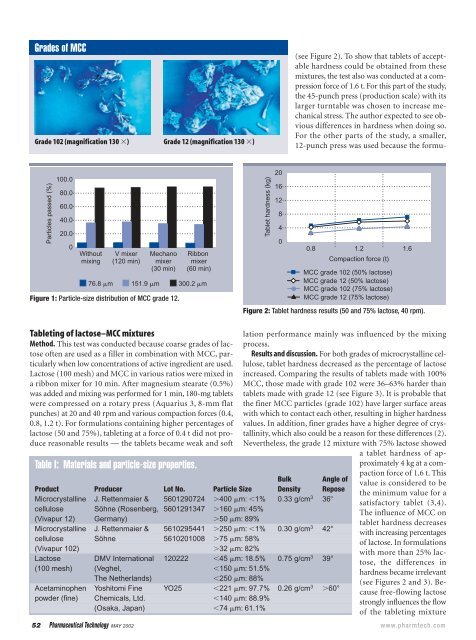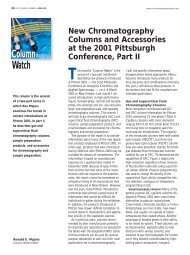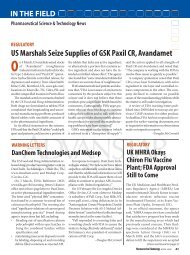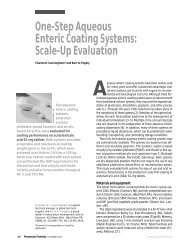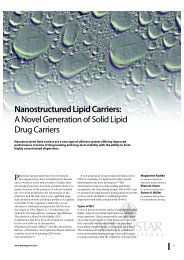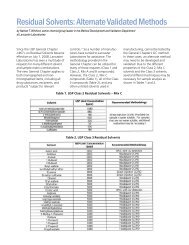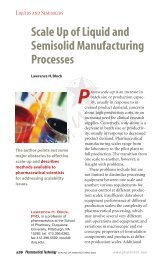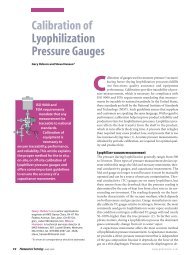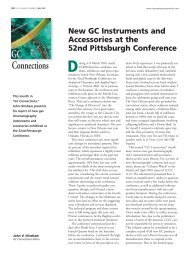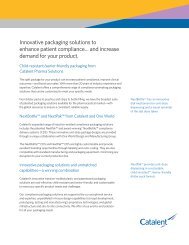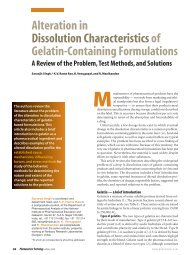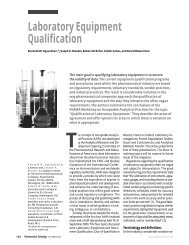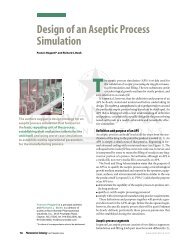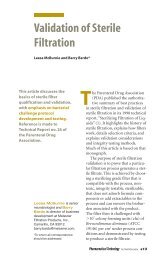Microcrystalline Cellulose Grade 12 versus Classic Grade 102
Microcrystalline Cellulose Grade 12 versus Classic Grade 102
Microcrystalline Cellulose Grade 12 versus Classic Grade 102
Create successful ePaper yourself
Turn your PDF publications into a flip-book with our unique Google optimized e-Paper software.
<strong>Grade</strong>s of MCC<br />
<strong>Grade</strong> <strong>102</strong> (magnification 130 ) <strong>Grade</strong> <strong>12</strong> (magnification 130 )<br />
Particles passed (%)<br />
100.0<br />
80.0<br />
60.0<br />
40.0<br />
20.0<br />
0<br />
Without<br />
mixing<br />
V mixer<br />
(<strong>12</strong>0 min)<br />
Mechano<br />
mixer<br />
(30 min)<br />
Ribbon<br />
mixer<br />
(60 min)<br />
76.8 m 151.9 m 300.2 m<br />
Figure 1: Particle-size distribution of MCC grade <strong>12</strong>.<br />
Tablet hardness (kg)<br />
20<br />
16<br />
<strong>12</strong><br />
8<br />
4<br />
0<br />
0.8 1.2<br />
1.6<br />
Compaction force (t)<br />
MCC grade <strong>102</strong> (50% lactose)<br />
MCC grade <strong>12</strong> (50% lactose)<br />
MCC grade <strong>102</strong> (75% lactose)<br />
MCC grade <strong>12</strong> (75% lactose)<br />
Figure 2: Tablet hardness results (50 and 75% lactose, 40 rpm).<br />
Tableting of lactose–MCC mixtures<br />
Method. This test was conducted because coarse grades of lactose<br />
often are used as a filler in combination with MCC, particularly<br />
when low concentrations of active ingredient are used.<br />
Lactose (100 mesh) and MCC in various ratios were mixed in<br />
a ribbon mixer for 10 min. After magnesium stearate (0.5%)<br />
was added and mixing was performed for 1 min, 180-mg tablets<br />
were compressed on a rotary press (Aquarius 3, 8-mm flat<br />
punches) at 20 and 40 rpm and various compaction forces (0.4,<br />
0.8, 1.2 t). For formulations containing higher percentages of<br />
lactose (50 and 75%), tableting at a force of 0.4 t did not produce<br />
reasonable results — the tablets became weak and soft<br />
Table I: Materials and particle-size properties.<br />
Bulk Angle of<br />
Product Producer Lot No. Particle Size Density Repose<br />
<strong>Microcrystalline</strong> J. Rettenmaier & 560<strong>12</strong>90724 400 m: 1% 0.33 g/cm 3 36<br />
cellulose Söhne (Rosenberg, 560<strong>12</strong>91347 160 m: 45%<br />
(Vivapur <strong>12</strong>) Germany) 50 m: 89%<br />
<strong>Microcrystalline</strong> J. Rettenmaier & 56<strong>102</strong>95441 250 m: 1% 0.30 g/cm 3 42°<br />
cellulose Söhne 56<strong>102</strong>01008 75 m: 58%<br />
(Vivapur <strong>102</strong>) 32 m: 82%<br />
Lactose DMV International <strong>12</strong>0222 45 m: 18.5% 0.75 g/cm 3 39°<br />
(100 mesh) (Veghel, 150 m: 51.5%<br />
The Netherlands) 250 m: 88%<br />
Acetaminophen Yoshitomi Fine YO25 221 m: 97.7% 0.26 g/cm 3 60°<br />
powder (fine) Chemicals, Ltd. 140 m: 88.9%<br />
(Osaka, Japan) 74 m: 61.1%<br />
(see Figure 2). To show that tablets of acceptable<br />
hardness could be obtained from these<br />
mixtures, the test also was conducted at a compression<br />
force of 1.6 t. For this part of the study,<br />
the 45-punch press (production scale) with its<br />
larger turntable was chosen to increase mechanical<br />
stress. The author expected to see obvious<br />
differences in hardness when doing so.<br />
For the other parts of the study, a smaller,<br />
<strong>12</strong>-punch press was used because the formulation<br />
performance mainly was influenced by the mixing<br />
process.<br />
Results and discussion. For both grades of microcrystalline cellulose,<br />
tablet hardness decreased as the percentage of lactose<br />
increased. Comparing the results of tablets made with 100%<br />
MCC, those made with grade <strong>102</strong> were 36–63% harder than<br />
tablets made with grade <strong>12</strong> (see Figure 3). It is probable that<br />
the finer MCC particles (grade <strong>102</strong>) have larger surface areas<br />
with which to contact each other, resulting in higher hardness<br />
values. In addition, finer grades have a higher degree of crystallinity,<br />
which also could be a reason for these differences (2).<br />
Nevertheless, the grade <strong>12</strong> mixture with 75% lactose showed<br />
a tablet hardness of approximately<br />
4 kg at a compaction<br />
force of 1.6 t. This<br />
value is considered to be<br />
the minimum value for a<br />
satisfactory tablet (3,4).<br />
The influence of MCC on<br />
tablet hardness decreases<br />
with increasing percentages<br />
of lactose. In formulations<br />
with more than 25% lactose,<br />
the differences in<br />
hardness became irrelevant<br />
(see Figures 2 and 3). Because<br />
free-flowing lactose<br />
strongly influences the flow<br />
of the tableting mixture<br />
52 Pharmaceutical Technology MAY 2002 www.pharmtech.com


